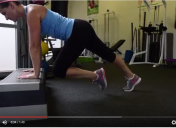Exertional Rhabdomyolysis – When Pain Does Not Mean Gain
What is rhabdomyolysis?
Rhabdomyolysis refers to the disintegration of muscle, due to the breakdown of individual muscle cells and the contents of the cell being released into circulatory system or bloodstream. One of the key compounds released is myoglobin, a protein that has an oxygen carrying capacity. The unusually high levels of myoglobin in the bloodstream burden the kidneys and the potential for acute renal failure can occur. Common situations in which the condition can occur include seizures, alcohol abuse and compression. It can also be caused by strenuous exercise. This is called exertional rhabdomyolysis and unfortunately cases have been reported after exercise sessions this summer.
Exertional rhabdomyolysis could be described as an extreme case of delayed onset muscle soreness or DOMS. It is triggered when muscles start to break down during strenuous exercise.
When does it occur?
When we do an exercise there is an eccentric and concentric phase. If we use a squat for example, the eccentric phase = going down. The concentric phase = coming up. There is also an isometric phase. This would be going into a squat and holding for an extended time. The ‘hold’ is an isometric contraction. Damage to the muscle cell can occur during concentric and isometric exercise but most frequently occurs during eccentric exercise or ‘negatives’. Individuals diagnosed with exertional rhabdomyolysis have often performed exercise that is unaccustomed and exhaustive (to “max” or “failure”) and the muscle cells of the exercised muscle break down under the workload.
What to look out for:
- Extremely painful DOMS (delayed onset muscle soreness). Often described as “excruciating”.
- Swelling or edema of the affected muscle(s).
- A loss of joint movement and limb function. For example, being unable to straighten your arms.
- Brown-reddish urine, sometimes described as tea coloured.
If you experience ANY of these symptoms, seek medical advice IMMEDIATELY.
What You Can Do to Protect Yourself from Exertional Rhabdomyolysis:
- Progress gradually in your workout program according to your existing fitness, whether it’s cardio, circuit or weights.
- Monitor your fluid intake, particularly when your workout is long, intense or hot, especially all three together. Aim for ~250ml (1 cup) every 15minutes.
- Don’t exercise hard on low-calorie diets or after long fasting periods. Ensure you have sufficient fuel on board to allow your muscles to work efficiently. Be careful of low-carb diets mixed with hard and long exercise.
- Avoid strenuous exercise in hot and/or humid conditions.
- Avoid alcohol before exercise. For example if you intend to exercise after lunch.
- Always inform your health practitioner(s) you intend to commence an exercise program, particularly if you use prescribed medication.
If you have any questions regarding this condition please speak to one of our staff or send us an email.








